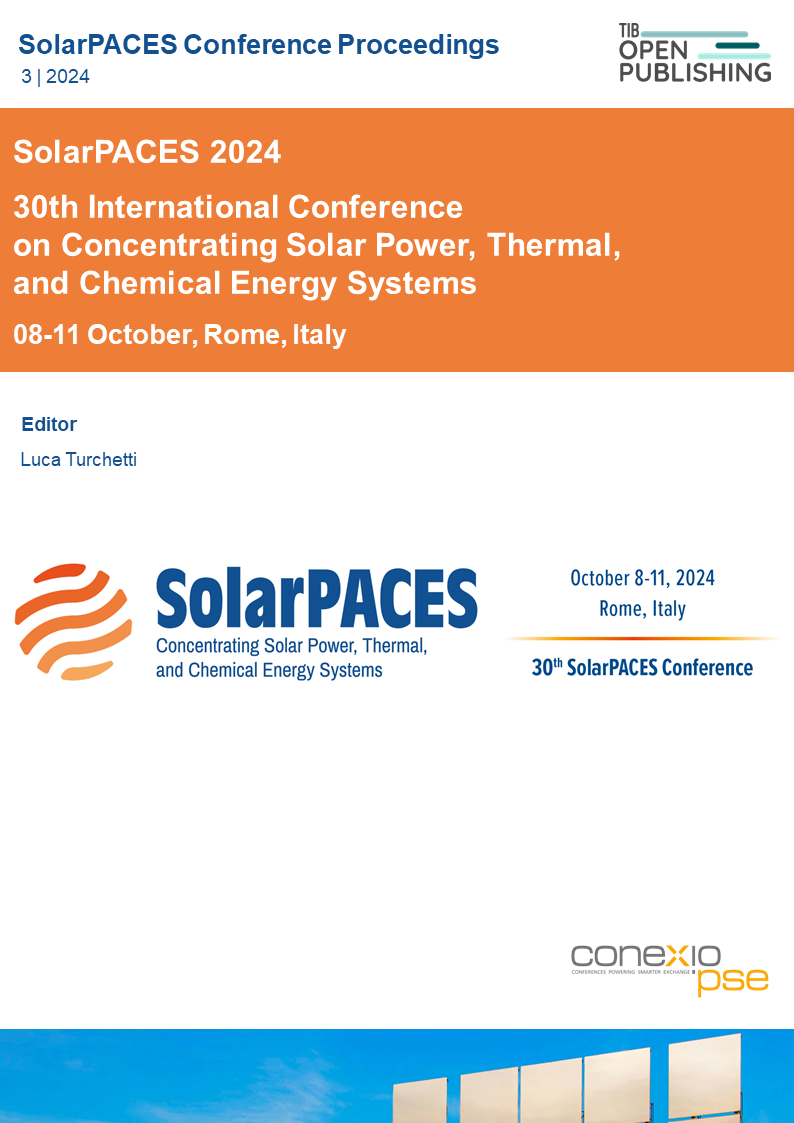Numerical Simulation to Investigate Thermal Stratification in an Energy Storage System Under No-Flow Condition
DOI:
https://doi.org/10.52825/solarpaces.v3i.2297Keywords:
Thermal Energy Storage (TES), No-Flow Thermocline Storage System, Stratification Number (Str), Mix Number (MIX), Charging and Discharging ProcessesAbstract
Thermal energy storage (TES) systems enhance the reliability of intermittent energy sources. The present work examines the thermal stratification in a thermocline storage system during charging and discharging with no fluid flows. With this goal, numerical simulations are performed on a storage tank consisting of a constant temperature heat source and sink. Molten nitrate salts mixture (60 % NaNO3+ 40 % KNO3) is used as storage material as it is thermally stable at higher temperatures (up to 565 °C). The thermocline behaviour of the numerical model is assessed during charging and discharging using constant temperature heating and cooling sources. In the present study, molten salts' lower and upper-temperature limits are 300 °C and 500 °C, respectively. The qualitative behaviour of thermocline formation and propagation during charging and discharging is analysed by temperature contours and axial temperature profiles. Quantitatively, the thermocline behaviour is analysed by two non-dimensional parameters: Stratification number (Str) and Mix number (MIX). It is observed that with a constant temperature heat source and sink, the tank remains stratified throughout the charging and discharging. The charging and discharging rates have been determined, and the results will be helpful in designing a lab-scale thermocline demonstration setup and further study.
Downloads
References
[1] A. Palacios, C. Barreneche, M. Navarro, and Y. Ding, “Thermal energy storage technolo-gies for concentrated solar power–a review from a materials perspective,” Renewable Energy, vol. 156, pp. 1244–1265, 2020. DOI: https://doi.org/10.1016/j.renene.2019.10.127.
[2] R. Bay´on and E. Rojas, “Simulation of thermocline storage for solar thermal power plants: From dimensionless results to prototypes and real-size tanks,” International Jour-nal of Heat and Mass Transfer, vol. 60, pp. 713–721, 2013. DOI: https://doi.org/10.1016/j.ijheatmasstransfer.2013.01.047.
[3] J.E.Pacheco, S.K.Showalter, and W. J. Kolb, “Development of a molten-salt thermocline thermal storage system for parabolic trough plants,” J. Sol. Energy Eng., vol. 124, no. 2, pp. 153–159, 2002. DOI: https://doi.org/10.1115/1.1464123.
[4] K. Kumar, V. Joshi, S. B. Kedare, and M. Bose, “Performance assessment of a porous flow distributor in arresting the effect of temperature fluctuation in a thermocline system,” Thermal Science and Engineering Progress, vol. 55, p. 102942, 2024. DOI: https://doi.org/10.1016/j.tsep.2024.102942.
[5] C. Mira-Hern´andez, S. Flueckiger, and S. Garimella, “Numerical simulation of single- and dual-media thermocline tanks for energy storage in concentrating solar power plants,” Energy Procedia, vol. 49, pp. 916–926, 2014. DOI: https://doi.org/10.1016/j.egypro.2014.03.099.
[6] P. Gajbhiye, N. Salunkhe, S. Kedare, and M. Bose, “Experimental investigation of single media thermocline storage with eccentrically mounted vertical porous flow distributor,” Solar Energy, vol. 162, pp. 28–35, 2018. DOI: https://doi.org/10.1016/j.solener.2017.12.062.
[7] W. Shaikh, A. Wadegaonkar, S. Kedare, and M. Bose, “Numerical simulation of single media thermocline based storage system,” Solar Energy, vol. 174, pp. 207–217, 2018. DOI: https://doi.org/10.1016/j.solener.2018.08.084.
[8] P. Gajbhiye, S. Kedare, and M. Bose, “Experimental analysis of parameters influencing thermal stratification in single media single tank storage system with flow distributor,” Thermal Science and Engineering Progress, vol. 30, p. 101243, 2022. DOI: https://doi.org/10.1016/j.tsep.2022.101243.
[9] V. Joshi, C. Wasnik, A. Wadegaonkar, S. B. Kedare, and M. Bose, “Influence of porosity and permeability of flow distributor on thermal stratification in single media storage tank,” Journal of Energy Storage, vol. 44, p. 103241, 2021. DOI: https://doi.org/10.1016/j.est.2021.103241.
[10] K. Kumar and S. Singh, “Investigating thermal stratification in a vertical hot water storage tank under multiple transient operations,” Energy Reports, vol. 7, pp. 7186–7199, 2021. DOI: https://doi.org/10.1016/j.egyr.2021.10.088.
[11] C.Xu, Z. Wang, Y. He, X. Li, and F. Bai, “Sensitivity analysis of the numerical study on the thermal performance of a packed-bed molten salt thermocline thermal storage sys-tem,” Applied Energy, vol. 92, pp. 65–75, 2012. DOI: https://doi.org/10.1016/j.apenergy.2011.11.002.
[12] “Comsol 2019. multiphysics reference guide for comsol 5.5.” (2019), [Online]. Available: https://doc.comsol.com/5.5/doc/com.comsol.help.comsol/COMSOL_ReferenceManual.pdf (visited on 08/15/2024).
[13] J. Fernandez-Seara, F. J. Uhı, J. Sieres, et al., “Experimental analysis of a domestic electric hot water storage tank. part ii: Dynamic mode of operation,” Applied thermal en-gineering, vol. 27, no. 1, pp. 137–144, 2007. DOI: https://doi.org/10.1016/j.applthermaleng.2006.05.004.
[14] J. H. Davidson, D. Adams, and J. Miller, “A coefficient to characterize mixing in solar water storage tanks,” 1994. DOI: https://doi.org/10.1115/1.2930504.
Published
How to Cite
Conference Proceedings Volume
Section
License
Copyright (c) 2025 Kapil Kumar, Shireesh B. Kedare, Manaswita Bose

This work is licensed under a Creative Commons Attribution 4.0 International License.
Accepted 2025-04-28
Published 2025-11-19
